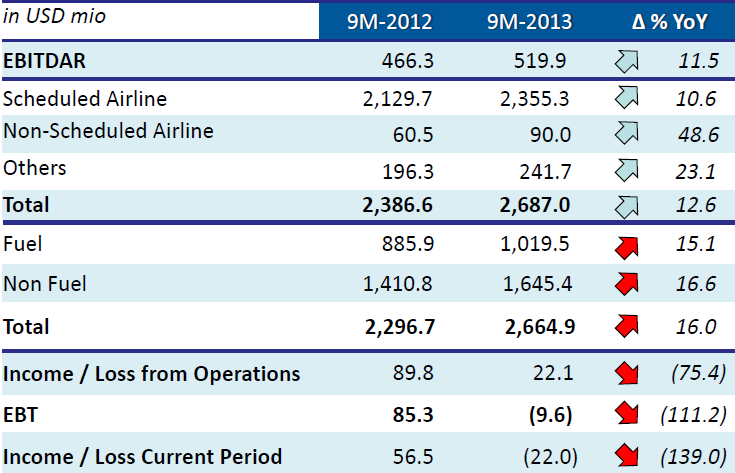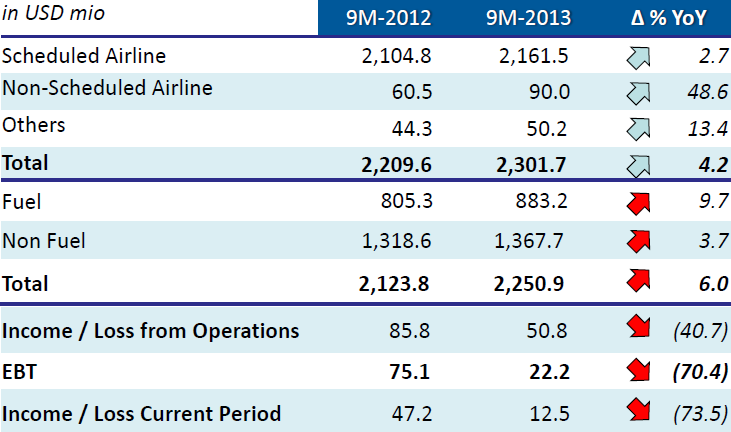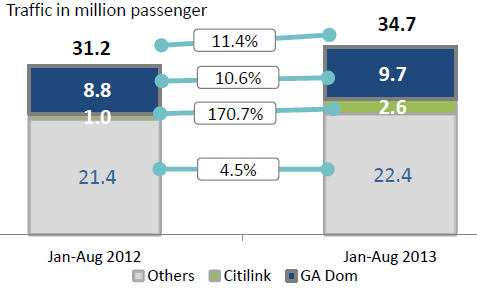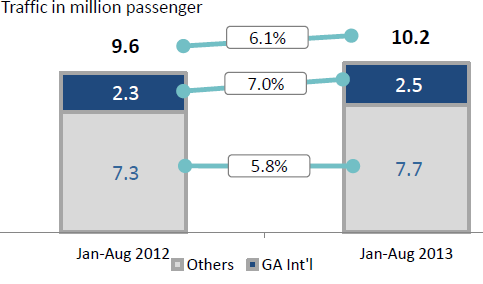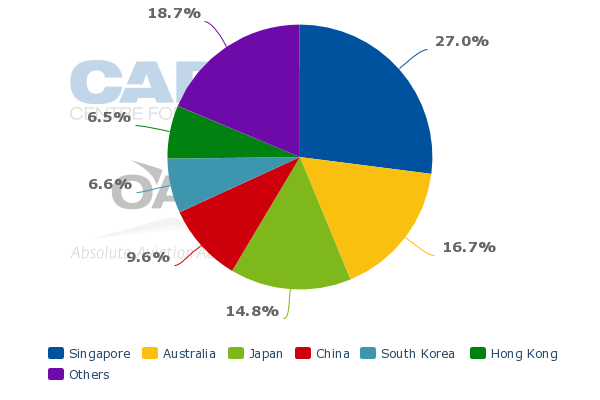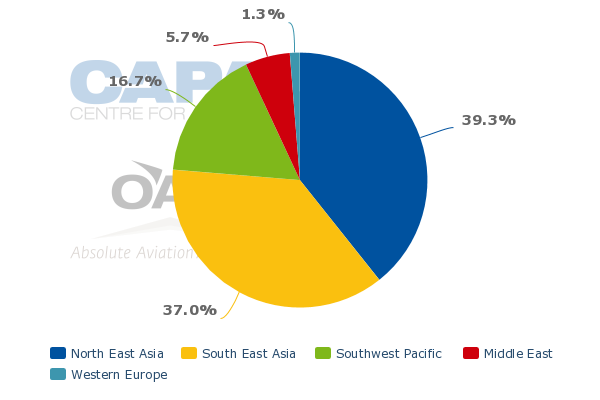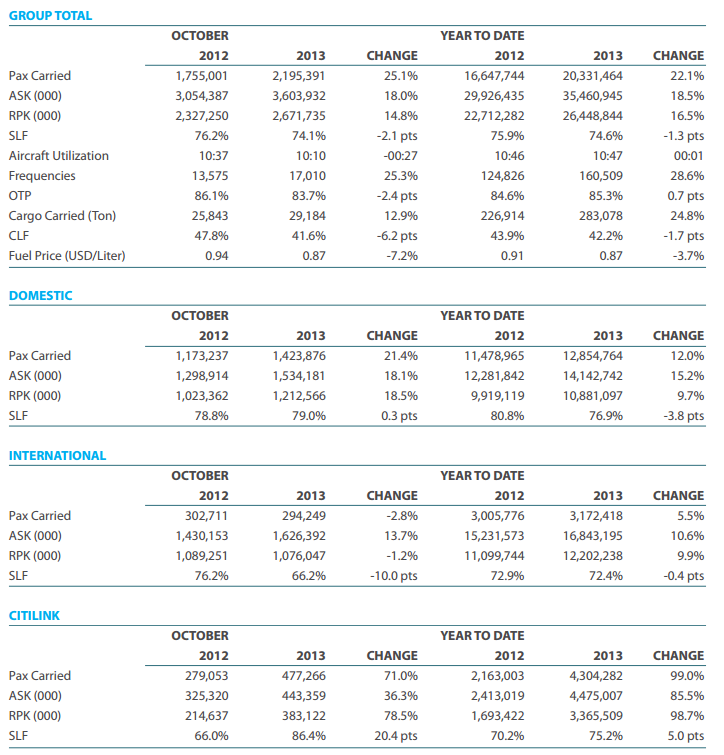Garuda Indonesia plans more rapid expansion for 2014 and beyond despite intensifying competition
Garuda Indonesia plans to again expand at a 20% clip in 2014 as the airline group adds another 26 aircraft. While competition is intensifying in Indonesia and regionally, Garuda is confident there is sufficient demand to continue supporting rapid expansion in 2014 and over the medium to long term.
The group has expanded capacity by about 20% in 2013, with international ASKs up by about 11% and domestic ASKs up by over 30%, driven primarily by budget subsidiary Citilink. Garuda plans to pursue a similar mix of domestic and international expansion in 2014.
On the international side, 2014 will see the carrier launch its first non-stop route to Europe, Jakarta-London. Garuda is not likely to launch other new European destinations until 2015 but capacity will expand to North Asia as Garuda is mainly using its new 777-300ER fleet on Japanese routes. Domestically, Citilink will continue to grow rapidly while Garuda will expand as it starts to deploy its new fleet of ATR 72 turboprops.
Garuda group fleet to reach 160 aircraft by end of 2014
Garuda expects group passenger numbers will be up another 20% in 2014, roughly matching the growth for 2013, while ASKs will be up between 15% and 20%. "We aren't going to slow down. That's our cruising speed," Garuda CEO Emirsyah Satar told CAPA in Nov-2013 on the sidelines of the Association of Asia Pacific Airlines (AAPA) Assembly of Presidents.
Mr Satar says Garuda mainline plans to end 2014 with a fleet of 128 aircraft compared to an anticipated 110 aircraft at the end of 2013. The Citilink fleet is slated to grow by eight aircraft from 24 A320s at the end of 2013 to 32 A320s by the end of 2014. Garuda currently operates 107 aircraft while Citilink operates 24 aircraft (excludes seven 737-300/400s that remains on the books but have been deactivated by Citilink in recent months).
Garuda Indonesia group fleet: as of 9-Dec-2013
| Aircraft | In Service | In Storage | On Order* |
|---|---|---|---|
| Total: | 131 | 8 | 110 |
| Airbus A320-200 | 24 | 0 | 15 |
| Airbus A320-200NEO | 0 | 0 | 35 |
| Airbus A330-200 | 10 | 0 | 1 |
| Airbus A330-300 | 6 | 0 | 0 |
| Airbus A330-300E | 1 | 0 | 17 |
| ATR 72-212A(72-600) | 1 | 0 | 24 |
| Boeing 737-300 | 3 | 6 | 0 |
| Boeing 737-400 | 0 | 1 | 0 |
| Boeing 737-500 | 4 | 1 | 0 |
| Boeing 737-800 | 63 | 0 | 6 |
| Boeing 737-800(ETOPS) | 1 | 0 | 0 |
| Boeing 747-400 | 2 | 0 | 0 |
| Boeing 777-300ER | 4 | 0 | 6 |
| Canadair Ltd CL-600-2E25(CRJ1000NG) | 12 | 0 | 6 |
Mr Satar says Garuda is slated to take delivery of 12 737-800s in 2014 but plans to return two older model 737-800s and phase out its last five 737-300/400 Classics. The mainline fleet expansion also includes four additional A330s for a total of 22. Garuda now operates 17 A330s, including 10 -200s and seven -300s, with one more to be delivered by the end of Dec-2013.
Garuda also plans to take two additional 777-300ERs and six ATR 72-600s in 2014, giving the carrier a fleet of six 777-300ERs and eight ATR 72-600s. Garuda this year took its first batch of four 777-300ERs from a 10-aircraft order. The first of at least 25 ATR 72s was delivered on 25-Nov-2013 and a second aircraft is slated for delivery by the end of Dec-2013. The first ATR 72 was placed into service on 3-Dec-2013 and is operating from the resort island of Bali to Labuan Bajo, Ende and Bima.
Garuda expands regional operation under Explore sub-brand
As CAPA first reported in early Nov-2013, the first batch of ATR 72s are being based at Bali and used to open new destinations to neighbouring islands that were previously not served by Garuda. Such regional destinations were previously primarily served by Lion Air regional subsidiary Wings Air and struggling government-owned regional carrier Merpati.
See related report: Merpati Nusantara Airlines faces crisis. Should the Indonesia government pull the plug?
Garuda sees an opportunity to penetrate some of the many Indonesian regional airports which cannot accommodate jets. Indonesia's archipelago and mountainous geography prohibit the development of long runways at many locations. As Indonesia rapidly develops economically, particularly in the more remote central and eastern portions of the country, demand at many regional turboprop-only airports is increasing. The ATR 72 is an important new tool for Garuda to access smaller but rapidly growing markets and provide new regional connections to business passengers.
Garuda believes a lack of competition has allowed Wings to charge relatively high fares on very short sectors despite its LCC model, resulting in a high level of profitability. Garuda plans to compete against Wings for point-to-point passengers on short island hops and also give passengers heading to or from regional airports a new full-service option, with connections to domestic trunk routes and across its international network.
In late Nov-2013 Garuda unveiled a new sub-brand, Explore, for its ATR 72 operation. Additional turboprop bases to be opened in 2014 include Ambon and Makassar, allowing the carrier to open up several new destinations in central and eastern Indonesia.
Garuda initially planned to allocate the group's ATR 72s to Citilink but earlier this year decided to instead have the turboprops, which are in single-class configuration with 70 seats, be operated by Garuda. Mr Satar told CAPA that the group wanted Citilink to focus on a single aircraft type and a point-to-point product. "The turboprop would divert the focus," he explained.
Garuda brands CRJ1000 operation Explore Jet
Garuda at the same time as launching the turboprop operation also started using the sub-brand Explore Jet for its Bombardier CRJ1000 regional jet operation. Garuda took its first CRJ1000, which it operates in two-class configuration, in Oct-2012, and currently operates 12 of the type, according to the CAPA Fleet Database. The six CRJ1000s remaining in its 18-aircraft commitment are slated to be delivered by the end of 2014.
The CRJ1000s have opened up new thin routes from four bases - Balikpapan, Medan, Makassar and Surabaya. The aircraft operate significantly longer sectors than the ATR 72s, including a small number of international routes.
Garuda currently has no intentions of expanding its commitment for CRJ1000s. The group however is now looking to significantly expand its commitments for narrowbody and widebody aircraft to enable continued growth of approximately 20% per annum.
Garuda plans another huge batch of new orders and lease commitments
The group is currently committed to acquiring an additional 56 narrowbody, 24 widebody and 30 regional aircraft (includes orders placed with manufacturers and announced commitments with leasing companies), according to the CAPA Fleet Database. About half of these aircraft, including almost all of the widebodies, are slated to be delivered by the end of 2015. The group is planning to expand its new aircraft commitment in 2014 by approximately 200 aircraft as part of a plan to grow the group's fleet to approximately 350 to 400 aircraft by 2025.
Additional A320neos, which have already been ordered for Citilink, and the 737 MAX are being evaluated for a new-generation narrowbody requirement at Garuda mainline. Additional new-generation narrowbody aircraft could also be ordered for Citilink beyond the 35 A320neos already on order. Additional 777s along with new generation 787s and A350s are being evaluated for a widebody requirement. A mix of orders and new lease commitments are expected.
The new long-term fleet plan seems ambitious but is realistic given the rapid growth in the Indonesian market. The Indonesian market is expected to continue seeing high double-digit annual passenger growth, driven by continued economic growth, which has exceeded 6% in recent years, and a rapidly expanding middle class.
Southeast Asia also has emerged as one of the fastest growing regions globally. With Indonesia by far the largest market in Southeast Asia, Garuda is well positioned to benefit from the continued rapid growth in air travel within, to and from Southeast Asia.
Competition however is intensifying in Indonesia and throughout Southeast Asia at both the budget and full-service ends of the market. Garuda mainline has seen its profits slide in 2013 while Citilink remains unprofitable. While the market conditions remain favourable for growth, over-capacity is a concern, clouding Garuda's outlook for the short to medium term.
Garuda profits fall in 2013
The group incurred a USD22 million loss in the first three quarters of 2013 compared to a USD57 million profit in the first three quarters of 2012. Passenger revenues for the nine month period were up only 11% to USD2.4 billion despite a 17% increase in RPKs as yield was down 4.5% to USD9.1 cents and average load factor dropped 1.2ppt to 74.6%. Garuda is not alone - most Southeast Asian carriers have seen yields drop in 2013 as competition has increased throughout the region.
Garuda Indonesia group financial highlights: 9M2013 vs 9M2012
Garuda's international yield dropped 2.4% in the first three quarters of 2013 to USD8.3 cents, which is a smaller reduction than most other flag carriers in the Southeast Asia region. Domestic mainline yields also dropped 3.4% to USD11 cents. Garuda blames the lower yields, particularly domestic yields, on the depreciation of the Indonesia rupiah, which has slipped over 10% compared to 2012. "Our international yields are quite good. It's only domestic because of the Rupiah," Mr Satar says.
Garuda's mainline operation has remained in the black, turning a USD51 million operating profit and a USD13 million net profit through the first three quarters of 2013 compared to an operating profit of USD86 million and net profit of USD47 million for the same period of 2012. Revenues increased 4% to USD2.3 billion.
Garuda Indonesia parent airline financial highlights: 9M2013 vs 9M2012
Citilink remained in the red in the first nine months of 2013, incurring an operating loss of USD46 million and net loss of USD45 million on revenues of USD198 million. Comparable figures are not available as Citilink was converted from a Garuda unit to subsidiary in mid-2012. The group has four other non-airline subsidiaries all of which were profitable and collectively generated USD414 million in revenues in the first three quarters of 2013.
Garuda group passenger traffic surges by over 20% in 2013
Garuda is on pace to exceed its original target of 15% to 20% passenger growth for 2013. Through the first 10 months of the year, the group's passenger traffic was up 22% to 20.3 million, including 16 million at Garuda mainline and 4.3 million at Citilink (see background information).
Garuda mainline ASKs were up 11% in the international market through the first 10 months of 2013 and 15% in the domestic market while ASKs at Citilink, which only operates domestically, were up 86% on a much lower base. As a group ASKs were up 19% while RPKs grew by 17% compared to the first 10 months of 2012.
Garuda estimates it has captured 27% of Indonesia's domestic market and 26% of Indonesia's international market based on passenger data at its four main hubs (Jakarta, Bali, Surabaya and Makassar) for the first eight months of 2013. Garuda's domestic market share has been rising, driven by growth at both Citilink and Garuda mainline.
Garuda mainline domestic passenger traffic at Jakarta, Bali, Surabaya and Makassar combined grew by 11% in the first eight months of 2013 while Citilink traffic grew by 171%. Traffic at other carriers grew by just under 5%.
Domestic passenger traffic at Jakarta, Bali, Surabaya and Makassar: 8M2013 vs 8M2012
Garuda's international traffic at the same group of four airports grew by 7%, slightly outstripping the 6% growth recorded by other carriers.
International passenger traffic at Jakarta, Bali, Surabaya and Makassar: 8M2013 vs 8M2012
Citilink struggles financially but continues to expand
Citilink growth will slow down in 2014 from the 86% ASK growth rate seen so far in 2013 but will remain well above the Indonesian industry average. Profitability will continue to be a challenge at Citilink as competition in the LCC sector is particularly fierce, with Lion, Indonesia AirAsia and Tigerair Mandala all expanding rapidly. Garuda has not provided any estimate on when it expects Citilink to be profitable.
After posting an operating profit margin of negative 23% in the first three quarters of 2013, the short to medium term outlook at Citilink remains cloudy. Garuda is confident in its two brand strategy and says the group has succeeded at product segmentation with both brands recording high load factors on overlapping routes with limited cannibalisation. But Garuda warns that Citilink is still at an early stage of development, which indicates that more losses are likely in 2014.
Garuda mainline will also continue to pursue double-digit domestic growth, driven partially by the new regional operation along with further expansion of the 737-800 fleet. Garuda is looking at using some of the additional 737-800s slated to be added in 2014 to launch flights from Jakarta alternative airport Halim. The Indonesian Government has said it will open up Halim, which now can only be accessed by small turboprop air taxi services, to scheduled commercial flights. Other Indonesian carriers have indicated they also plan to serve Halim, including Lion full-service subsidiary Batik Air.
Garuda intends to use Halim for some flights on domestic trunk routes such as Jakarta-Surabaya. Halim will be limited to point-to-point services but Garuda has the frequencies on the trunk routes to move some flights to Halim while continuing to maintain connections at Jakarta Soekarno-Hatta. Batik's plans to move its entire Jakarta operation from Soekarno-Hatta to Halim puts pressure on Garuda to respond by also operating flights from Halim, focusing on routes popular with business passengers.
See related report: Lion Air full-service subsidiary Batik Air to expand with A320s, 787s and new base at Jakarta Halim
Darwin could be launched as next phase of regional international expansion
Garuda's international expansion during 2013 has come regionally within Asia. Long-haul expansion was delayed as Garuda in Jul-2013 decided to postpone the launch of 777-300ER flights to London Gatwick from Nov-2013 to May-2014.
See related report: Garuda Indonesia's international ambitions set back by London postponement
Garuda still plans to allocate a portion of its new 777-300ER fleet to offer same-plane one-stop service from Sydney to London. Capacity to Australia was already added earlier in 2013 as Garuda launched service from Perth to Jakarta in Jun-2013 and from Brisbane to Bali in Aug-2013. (Garuda already served Perth from Bali. It does not yet serve Brisbane from Jakarta. The carrier's other two Australian destinations, Melbourne and Sydney, are served from both Bali and Jakarta.)
Mr Satar says Garuda is looking at further expansion in Australia including Brisbane to Jakarta and Darwin to Bali, Surabaya or Kupang. Garuda suspended service to Darwin in 2009 but the Darwin market has since become more attractive given the rapid expansion of northern Australia's oil and gas sector. Singapore Airlines (SIA) regional subsidiary SilkAir and more recently Philippine Airlines (PAL) and Malaysia Airlines (MAS) have all entered the Darwin market. "We are looking at it, but that Darwin traffic won't be a feeder to the London route," Mr Satar told CAPA. "It will be connected to Bali or Kupang or Surabaya."
Bali is the most likely option as it will allow for connections from Darwin to Korea and Japan, growing markets which SilkAir/SIA, MAS and PAL have successfully targeted. Bali is the only Indonesian airport currently served from Darwin, with service from Indonesia AirAsia and Jetstar Airways.
Mr Satar says Garuda is also seeking to partner an Australian carrier to feed Darwin from regional destinations in northern Australia such as Alice Springs. "Before we go in, we need to make sure we can make those connections," he says.
Garuda unlikely to add second European non-stop route in 2014
Garuda initially planned further growth of its European network in 2014 with Frankfurt, Paris, Rome and Milan candidates following London. But the carrier is now unlikely to add new European destinations until at least 2015. Garuda will instead focus on trying to achieve profitability on the London route and using most of its 777-300ER capacity for Australia and North Asia. (Garuda's only current European destination, Amsterdam, is served with A330s via Abu Dhabi.)
Garuda currently uses 777-300ERs on its Tokyo Narita to Bali and Jakarta routes as well as on Seoul-Jakarta, Shanghai-Jakarta and Jeddah-Jakarta. The opportunity to use its first batch of 777-300ERs on North Asia routes came as the launch of Jakarta-London and the switch from A330s to 777-300ERs on Jakarta-Sydney were delayed. But Garuda has been very satisfied with the 777-300ER performance on North Asia routes, particularly to and from Tokyo Narita. (Garuda continues to use A330s from Tokyo Haneda and Osaka, both of which it only serves from Bali.)
Garuda is keen to continue using 777s to Tokyo Narita, as well as to Jeddah in Saudi Arabia, rather than revert back to A330s. But this means Garuda will likely not have the capacity for new European services until 2015, when it takes the final batch of 777-300ERs from its original 10-aircraft order. (Garuda is scheduled to soon revert back to the A330 on Seoul-Jakarta but at least for now has kept 777s in the Shanghai-Jakarta schedule, according to OAG data.)
"In Japan it is [the 777-300ER] doing very well," Mr Satar says. New Garuda executive vice president of marketing and sales Erik Meijer told CAPA that even for first class, which Garuda has introduced with the 777-300ER, the carrier sees demand ex-Japan. Tokyo-Jakarta has emerged as a big premium market, driven by growing business ties between the two countries while Bali is a large leisure market including for high end leisure passengers which fly in the premium cabins.
Garuda is also talking to potential new partners that would connect with the carrier's services at Tokyo Narita, further boosting demand for the Narita-Jakarta and Narita-Bali routes. The carrier plans to formally enter the SkyTeam Alliance in Mar-2014, helping the carrier boost its exposure internationally, particularly outside Asia-Pacific.
Japan is currently Garuda's third largest international market after Singapore and Australia, accounting for 15% of the carrier's international seat capacity.
Garuda international capacity share (% of seats) by country: 9-Dec-2013 to 15-Dec-2013
The Asia-Pacific region overall accounts for an overwhelming 93% of Garuda's international capacity.
Garuda international capacity share (% of seats) by region: 9-Dec-2013 to 15-Dec-2013
Garuda finally ready to launch London in May-2014
Garuda's international sales and marketing efforts are now largely focused on the UK market. Garuda is confident the London route will succeed despite the six month launch delay, which was caused by operational issues at Jakarta airport, and despite having to settle on Gatwick after not being able to secure slots at Heathrow at its preferred times. As CAPA reported in Jun-2013, Garuda only had the opportunity to acquire Heathrow slots at times that would not allow for connections beyond Jakarta to Australia and decided having the ideal schedule was more important than operating from its preferred airport.
See related report: Garuda Indonesia's attempt to compete in Australia-Europe market faces challenges
Garuda in Nov-2013 started accepting bookings for the revised London launch date of 29-May-2014. Mr Meijer expects strong sales ex-Jakarta as there is a large and growing number of Indonesians travelling to London, including in premium cabins, and Garuda will be the only carrier with a non-stop service in the market. But Garuda realises it will also need strong point of sales in the UK and Australia for the route to succeed.
Mr Meijer points out that the UK is the largest inbound market in Europe for Indonesia. Garuda has started working on building up its brand presence in the UK, where it is marketing its connections to Bali and other Indonesian tourist destinations as well as Australia.
Garuda will offer low fares in markets such as London-Bali and London-Sydney to be competitive with Gulf and other Southeast Asian carriers. But Garuda is banking on higher yields in the local Jakarta-London point-to-point market. "You should not bet on UK-Bali," Mr Satar says. "If you look at London-Jakarta you are talking about business passengers and investment. It's mostly Indonesians going to London compared to Brits going to Indonesia. What we can do is sell the excess capacity at a [lower] yield."
Garuda faces challenges as it looks to become bigger international player
London will be an important test for Garuda as the carrier, which in the 1980s served several European destinations as well as the US, looks to restore some of its old glory. If London succeeds, Garuda will look to launch several more European routes, using its new 777-300ER flagship fleet and eventually the new generation widebody aircraft it expects to order in 2014.
But London will be a challenging market as it has seen increased capacity from several other Southeast Asian carriers and is also well served by the Gulf carriers. Garuda's use of Gatwick puts it at a competitive disadvantage as business passengers generally prefer Heathrow, which virtually all other Asian carriers serve.
Garuda also has a much smaller international network within Asia than other major Southeast Asian flag carriers. The group in recent years has been focusing more on the domestic market - for good reason given the huge opportunities within Indonesia. But its smaller international network in ASEAN puts it at a disadvantage as it starts to build up its long-haul network because it will not be able to offer the same range of connections.
Garuda will also face challenges in 2014 closer to home as it has struggled so far to compete in the budget end of the market against Lion, which accounts for about half of domestic passenger traffic in Indonesia. Garuda needs to quickly turn around Citilink, which has been highly unprofitable since being converted from a unit of Garuda into a subsidiary in mid-2012. Garuda mainline has performed well domestically but faces new competition from Batik and will incur start-up costs associated with the launch of the Explore sub-brand.
Garuda overall is still well positioned to leverage its strong position in the dynamic and fast-growing Indonesian market. But there will be some growing pains as it continues to expand at a torrid 20% per year clip. Intensifying competition will also continue to put pressure on profits.
Background information
Garuda operational highlights: 10M2013 vs 10M2012
